~ THE TURNING OF THE WHEEL ~
Imbolc / Charming of the Plow 2010
Issue #6 is Coming Soon!
Dear Hexy Folks: Issue 5 sold out in dizzying record time, so to be sure of securing your copy of Issue 6 we strongly recommend getting in quickly and preordering (click the above image)!
Meanwhile, the good news is that we still have plenty of copies of
By the Hum of Ullr’s Bow: Winter Songs Compilation CD
available for purchase!
Bands on the compilation CD include:
• A Minority of One • Allerseelen • Andrew King • At the Head of the Woods
• Beastianity • Hamramr • Irij • Ironwood • Ruhr Hunter
• Sangre Cavallum • Sieben • Steve von Till • Svarrogh • Waldteufel • Wardruna
(You can read more about the artists here).
Hex is a community-supported not-for-profit publication. You can support us by clicking the image above and ordering magazines, CDs, and prints, and by spreading the word to all like-minded folk!
Share your creative spark – we are always accepting
submissions of art, articles, recipes, stories, poems!
Due date for Winter 2010 submissions is Spring Equinox 2010
submissions@hexmagazine.com
* * * * * *
Season of Lights
The Season of Lights comes creeping in
On cat feet of wind and frost,
Her cloak a lace patchwork of skeleton leaves
With whorls of ice embossed.
Kernels of brightness the Winter Crone bears
Like lamplight from faraway towns.
As she sweeps overhead, the luster of Spring
Peeps through the chinks in her gown.
The blessings of darkness she carries as well:
The darkness that lives before birth,
And that shadow abiding where solace awaits
In the deep dusky bosom of Earth.
~ Ilana Poppy Hamilton
* * * * * *
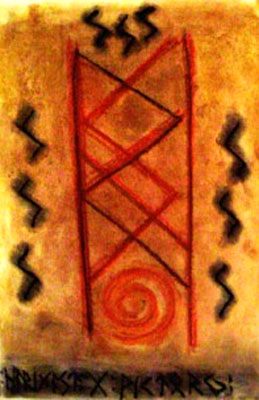
Sigil for the Accidental Invocation of Brigid
.: Imbolc: A Nod to Old Britain’s :.
.: Goddess of Spring and Planting :.
For those who look for information to better follow the ways of Norse, Germanic, and Scandinavian Heathenry it’s time to think about how to greet the coming spring. This most often means designing a ritual around the planting of the food crops and “The Charming of The Plow.” In the Old World that usually meant bonding with and asking for the blessing of Gods and Goddess, the local land spirits and perhaps anyone else who might help insure the crops are a success.
Such rituals have been carried out long before Heathen ways became the main source of spiritual belief across many of the lands Heathens are known to have inhabited. The British Isles had a one goddess that seemed to have been known far and wide before this time: Briged.
There are many variations of this Goddesses’ name, including, among many others, Bridget or Briget or Bride. She is well known from Irish folklore where her name meant something like “exalted one” or “high one.” Her influence across these lands was so strong that in the 5th century she became the Christian Saint Bridgid in Ireland.
In Scandinavian and Finnish areas it seems she was called Birgitta, who became a saint in Sweden in the 14th century: Saint Birgitta. This could be a form of Birger, or Old Norse Birgir, which is a masculine term that may have come from bjarga meaning “to help, to save, to protect.” In France the name Brigindona is inscribed in the Côte d’Or.
The Brigantii people were known to the early Romans in England, and they were called the people of the goddess Brigantia. Brigantia’s name could be derived from proto-Celtic briganti – which means “be high.” With the feminine ending -a the name Brigantia could be from the feminine Proto-Indo-Eurpean bhrg’hnti-, from a root berg’h or “high,” “lofty,” “elevated,” or perhaps “the high.” The Proto-Germanic burgundi- and Sanskrit brhat also mean “high.”
All these variations seem to show a somewhat universal familiarity with Brigid in one form or another throughout Europe and a high status. Caesar is credited with calling the British Isles by the name Britannia following his invasion of the Isles in 55 BC. The Britons were eventually overtaken by Germanic tribes, specifically the Angles, Saxons, and Jutes. Ireland eventually absorbed many of the Britons as their lands were overtaken.
Brigid is remembered at this time of year through the seasonal celebration of Imbolc. This is a festival of renewal, growth, and fertility. She was said to test the weather with her snake which is where Groundhog Day in the US is said to come from. She is also associated with the first milking of the ewes, something the Anglo-Saxons seemed to take up by referring to this month as Suhlmonaath, which could mean Plow month, or Ewomeolue, meaning Ewe-milk.[1]
Many folk festivals happen at about the same time or in the month of February, such as The Charming of the Plow, Disting, Candlemas, the Feast of Lights, Feast of Torches, Feast of the Virgin, Feast of the Waxing Light, Festival of the Ewe’s Milk, Festival of Lights, Candlelaria, and the Snowdrop Festival.
Many of the rituals that seem to be associated with Brigid could certainly fit into any Heathen practice, and indeed resemble some Heathen lore. Perhaps adding your own choice of Sun or Earth Goddess might be appropriate. The first Brigit-related ritual is the leaving of offerings for the Goddess such as milk, bread, seeds, or corn (grain) on the eve of February 2nd. Putting out the fires of the hearth and smoothing the ashes so that you can look for signs in them the next day as a form of divination is also very fitting. Another folkway associated with her is the lighting of lots of candles to welcome back the sun, and the wearing of a crown of candles by a young girl like that associated with the Scandinavian St Lucia, or Lussinatta.
Another custom is to create a corn dollie called a Brideo’gas, and a bed for her in a basket near the hearth. The bed would have white linens and would be dressed in white, given white flowers and a wand (slachdan Brighde), with an acorn at it’s top. Brigid was said to be born at sunrise as her father Dagda stood in the threshold of the door, so another custom tells how one of the women of the house would stand in the threshold and call to Brigid and let her know her bed was ready. Yet another custom was to place brooms (besom) near the door to chase out the old and welcome the new.
I hope these suggestions make your spring a time of joy in the blessings of your labors.
Hail Day!
~ Teresa Luedke, Heathen Hedgewife
[Editor’s note: Brigid seems to exert a strange attraction to many otherwise died-in-the-wool Germanic Heathens – yours truly included! She’s been haunting Hex for a little while now – the Hex Winter Songs: By the Hum of Ullr’s Bow CD features a track by Steve Von Till called “Brigit’s Cross.”]
End Notes, Bibliography & Further Reading:
[1] Smith, Mike. (2002). February. Paxson, Diana L. (Shope), Jack Hart Gen. Ed.The Old Heathen’s Almanac 2004, Berkeley, The Troth. Page 16.
Imbolc Traditions, Symbolism, and Lore
* * * * * *

• NAUTHIZ •
Old English Rune Poem
Need is tight in the breast; but it often
Happens for human’s children to help and to save
Each, if they listen to it early.
Old Icelandic Rune Poem
Need is a bondswoman’s yearning
And a difficult circumstance
And drudging work.
Old Norse Rune Poem
Need renders little choice;
The naked will freeze in the frost.
~ Rune poem translations by Sweyn Plowright
http://www.mackaos.com.au/Rune-Net/Primer/
This is the third time that Need has cropped up in my Hex Newsletter rune articles, and when I drew it I almost put it back and tried again! Yet that would be rather disrespectful…and the creative challenge of trawling the same waters for new reflections is too tempting to pass up!
If the end of winter is coming (and it is for all you Northern Hemisphere folks) then new questions are opening up: what am I to do and be with the rush of sap and blood that is on the way? Need may seem most pressing in hours of cold and darkness, but this is somewhat illusory: resistance and overcomings are always with us in all we do.
I have in mind an old story about The Man Who Does Not Fix His Roof. An old man lives in a run down shack, and there is a big hole in the roof. Every time it rains, his house floods, and he curses: “as soon as the sun comes out I’m fixing that stupid roof!” The sun comes out, everything dries off, and he starts putting it off and putting it off until the next time the rain comes. Once again, he swears to fix the roof, but of course, never quite gets to it. This continues in perpetuity.
There are so many experiences in life that find their reflection in this image – for example, anyone who has battled with recurring depression can probably relate at least a little bit to this parable abut how not to respond to Need.
The moral is simple: think about Need even when you don’t feel its abrasive touch. How do necessity and compulsion run through your life? What deserves to be trimmed away, what holes need patching? No need to overwhelm yourself with grandiose plans of change – a few small efforts to fix up this or that will ultimately bear great reward anyway.
By the same token, it is important not to let fear of the pressure of Need spoil times of hope or bounty. Many folk of my grandparents’ generation, scarred by the Great Depression and World War II, were and are incapable of enjoying the measure of material prosperity and security they attained in later years. The wounded miser enjoys not his wealth.
It is also important to consider that Need does not necessarily mean a lack of something. The compulsion to write, or play music, or make art, or learn about mythology, or cook good food, or keep a good house, or do a trade well: these all spring from Need. We are made to be engaged in the world around us.
Looked at this way, Need can even be a kind of superabundance, or at least the occasion for such fecundity. And I suspect that this rune could be invoked to turn a downward spiral into a soaring flight.
Cutting away the inessential, listening to the call of the Need for each of us to come more fully into our own lives, is a valuable exercise. What we do not Need – perhaps television, or badly behaved work clients, or poisonous fast food – well, it seems tautological, but these we can do without.
Focusing on the necessary can be surprisingly nourishing…and cutting out the needless might allow us to make room for what truly brings us joy.
If Nauthiz has come to be regarded as the bogey man of the runes, the scary one (scary because it reminds us that we have to make an effort), then perhaps it is time to begin to reclaim necessity as a positive force. In accepting the authentic restriction of Need we might just give ourselves a fighting chance at achieving our hearts’ fulfillment.
* * * * * *
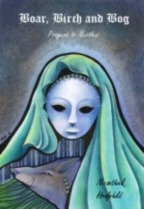
Boar, Birch, and Bog: Prayers to Nerthus
by Nicanthiel Hrafnhild
Nerthus is often overlooked among Heathens, and virtually unknown among non-Heathen Pagans, even those who worship and work with the Germanic Gods. Boar, Birch, and Bog: Prayers to Nerthus, a new devotional work from Gullinbursti Press by Nicanthiel Hrafnhild, is an attempt to bring this long-forgotten Goddess back into Her rightful place in the hearts
and minds of people. This book explores three of Her major facets, and their spheres of influence – Valor, Fertility, and Holiness.
Featuring original poetry, tales based on lore and UPG, and rituals for holy days associated with Nerthus, Boar, Birch, and Bog: Prayers to Nerthus is sure to inspire renewed devotion to and reflection on Herself, and the lessons She has to teach for modern Heathens and Pagans alike. Digital, soft, and hard cover editions are available.
* * * * * *
:Issue Three Almost Gone!:
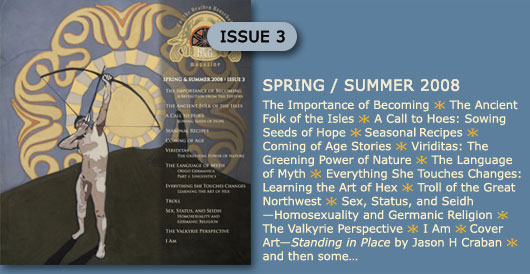
Issues One, Two, Four & Five are sold out!
Only limited numbers of Hex Issue Three remain…
Order at:
www.hexmagazine.com/subscribe/
* * * * * *
Until Ostara, may you and your household
be blessed and kept. Hail!
~ HEX Magazine
* * * * * *
We are currently looking for:
• submissions for e-zine content
• funding
If you are interested in applying or have any suggestions, contact: info@hexmagazine.com
* * * * * *
!!WE WANT YOUR AD!!
Support your community while exposing like-minded
folk to your goods and services…
Advertisements must be relevant to HEX readers, and inclined toward a Heathen aesthetic. Prices listedare for completed AD files. If you need additional graphic design, we can help. Just contact us about our design fee.
AD space is now available in the newsletter for $10 a run.
Contact info@hexmagazine.com if you are interested.
>I< HEX >I<
www.hexmagazine.com
> Please forward to all interested and relevant parties <



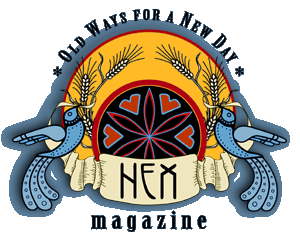

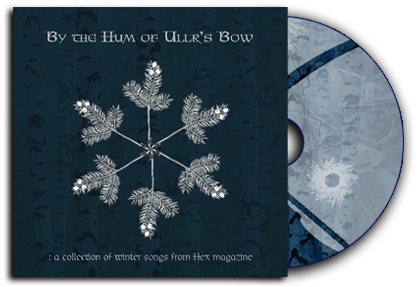






Leave a Reply